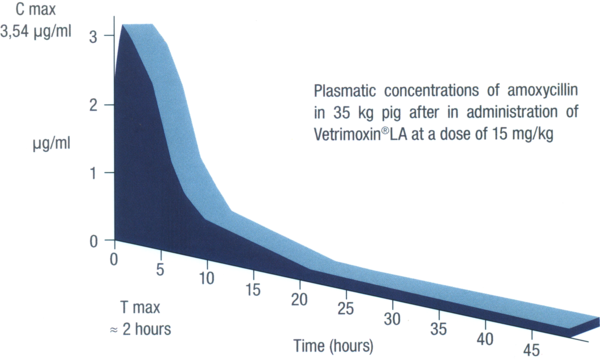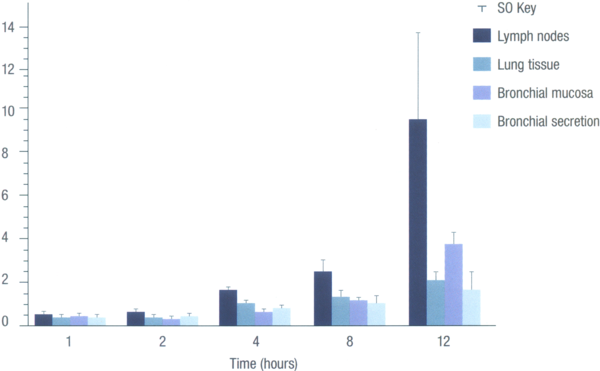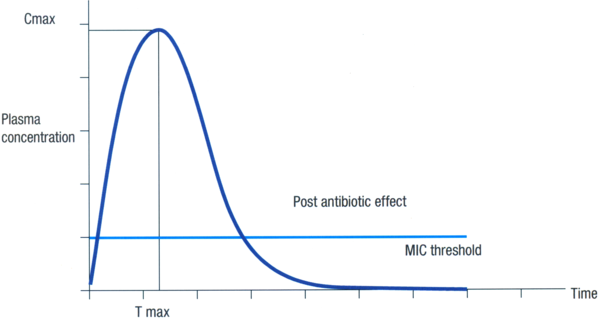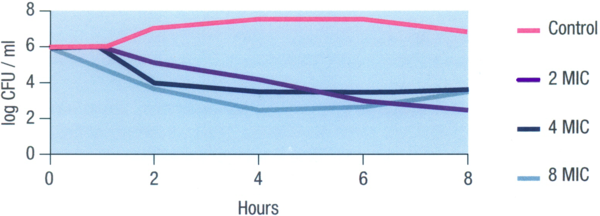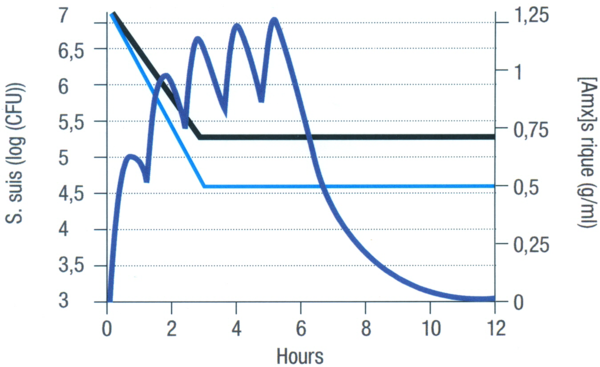--> Summary
--> Amoxicillin
--> Pharmacokinetic
--> Elimination
.
VETRIMOXIN® LA - Technical Profile -
.
SUMMARY
Vetrimoxin® LA is a long acting injectable amoxicillin. Amoxicillin is the bactericidal antibiotic of the becta-lactam family with a broad spectrum of activity on G- and G+ bacteria. It is inefficient against Mycoplasma. High concentrations after parenteral administration are found in lungs, brain, joints and kidneys.
Therapeutical indications include mainly uro-genital infections of sows, Streptococcal infections, Glasser’s disease, Porcine Pleuropneumonia and secondary bacterial respiratory infections, post-surgical and post-traumatic treatment. Fast and long lasting activity predispose Vetrimoxin® LA for both: treatment of clinical sick animals as well as prophylactic treatment.
Vetrimoxin® LA is a suspension consisting of a high grade micronized amoxicillin and specific components in the excipient. This unique composition together with a particular manufacturing process make Vetrimoxin® LA easy resuspendable, easy injectable and highly efficient stable product, the best injectable long acting amoxicillin on the market.
Legal environment renders Vetrimoxin® LA a first choice product for the treatment and prophylasis of specified diseases in the time, when prudent use of antibiotics is required by the authorities, veterinarians, farmers and consumers.
.
AMOXICILLIN
Physico-chemical properties
Amoxicillin belongs to the aminopenicillin group of the beta-lactam family of antibiotics. Chemically it is parahydroxyampicillin. This semi-synthetic drug was developed to overcome the major disadvantage of penicillins, which is the narrowness of their spectrum (Gram (+) cocci and baccilli, Gram (-) cocci). Amoxicillin’s spectrum extends to other Gram (-) micro-organisms, including enterobacteria.
The aminopenicillins group consists of ampicillin and amoxicillin: the latter is used much more commonly due to the numerous advantages it offers:
- Amoxicillin is much better absorbed after per os administration.
- Bioavailability of amoxicillin is higher than ampicillin (the latter estimated 40%).
- Solubility of amoxicillin is much higher
^ Top page
.
Amoxicillin - a semi-synthetic antibiotic
The presence should be noted of the hydroxyl (-OH) group on the benzene ring. Together, these two parts of the molecule constitute the phenol function which considerably modifies the physico-chemical properties of the drug. This is a unique structural feature of amoxicillin compared to ampicillin.
Amoxicillin base has a molecular weight of 365 dalton (420 dalton in trihydrate form) reflecting the molecule’s small size. This small size enhances transfer of amoxicillin across the membranes of the bacteria wall and the blood capillaries.
^ Top page
.
Amoxicillin’s small size is one of the factors which explains its good diffusion across biological membranes
At physiological pH (2.4 - 7.4), an equilibrium is reached between the ionic dipolar form and the un-ionized form: amoxicillin exists both in its ionized and un-ionized form. This indicates that at physiological pH, amoxicillin can be both:
- Dissolved in the plasma (ionized form),
- Diffused by passive membrane transfer (un-ionized form) even if the membrane transfer can occur also in the ionized form by active transfer.
In fact, amoxicillin is structurally analagous to amino acids which enables it to be absorbed by the same carriers.
Amoxicillin base is a compound which is both watersoluble and liposoluble. Due to its phenol function, amoxicillin is much more soluble in water than ampicillin (4 compared with 0.5 mg/l) as well as in lipid solvents (7.5 compared with 0.02 mg/l).
This dual characteristic (water- and lipo-solubility) is the reason for amoxicillin’s two principal strong points:
- Excellent behaviour in all the tissues of the organism
- Easier diffusion across the walls of Gram (+), as well as Gram (-) bacteria.
^ Top page
.
PHARMACOKINETIC
Amoxicillin is better resorbed than ampicillin, that is why it reaches higher concentrations in the blood and also it’s bioavailability is high.
A study of the pharmacokinetics of amoxicillin was conducted on pigs injected with Vetrimoxin® LA, at a dose of 15 mg of amoxicillin / kg of live weight (i.e. 1 ml of solution per 10 kg), via the intramuscular route. The results obtained were as follow:
Table 1 Pharmacokinetics of Vetrimoxin® LA
Figure 1 Pharmacokinetic profile of Vetrimoxin® LA
The distribution of amoxicillin in the tissues is determined by the acidic nature and water-solubility of the drug, the main reasons why distribution occurs mainly in the extracellular sector. Distribution is greatest in the blood capillaries allowing widespread distribution throughout the organism.
This of particular interest in relation to attacking micro-organisms located extracellularly such as Streptococci, Actinobacillus, Pasteurella, Staphylococci, Clostridia, Coli bacteria,… On the contrary, amoxicillin cannot easily reach micro-organisms located intracellularly, such as Salmonella or Lawsonia.
Diffusion to the tissues is facilitated by the low rate of binding to plasma proteins: a rate of approximately 15%. The free form, the only form which is active, thus diffuses rapidly to the organs and biological fluids.
^ Top page
.
TISSUE DISTRIBUTION
Although the principal location for amoxicillin is extracellular and in the plasma, the concentrations in the various tissues are important.
Tissues with high levels of amoxicillin concentrations: kidneys, lungs, joints, brain
For these tissues, the tissue / plasma ratio moves between 0.5 to 3 and occasionally even greater. The highest amoxicillin concentrations are found in the filtering organs, the liver and kidneys, and especially in the excretion fluids: bile and urine.
Biliary concentration: 10 to 20 times the concentration in the serum. Like all penicillins, amoxicillin concentrates in the bile and is subjected to an entero-hepatic cycle. The fraction eliminated via the bile may therefore be reabsorbed in active form in the digestive tract, ensuring a prolonged concentration of amoxicillin in the organism.
Kidney: The concentrations in the urine are 10 to 20 times higher than the concentration in the serum. The renal elimination of amoxicillin thus enables therapeutic concentrations to be attained in the urine.
Respiratory tract: The concentration of amoxicillin in bronchial secretions, lung tissue and diseased lung tissue peaks two hours after intravenous drug administration, while amoxicillin concentration in pleural fluid, lymph nodes and tonsil tissue peaks one hour after drug administration. The concentration of amoxicillin in secretions and tissue decreases by a slower rate than amoxicillin concentration in plasma, resulting in an increasing tissue-to-plasma concentration ratio (Figure 2). The distribution ratios (AUCtissue/JAUCplasma) is 0.53 for bronchial secretions, 0.44 for pneumonic lung tissue, 0.42 for lung tissue, 1.04 for pleural fluid, 0.58 for lymph nodes and 0.37 for tonsil tissue (Agerso, 1998).
Figure 2 Mean ration of amoxicillin concentration in tissue or secretion to plasma (Agerso, 1998)
The primary locations of bacteria in pneumonia are lymph nodes, bronchial secretions and bronchial mucosa. High and persistent concentrations of amoxicillin in thise tissues are important for the effective treatment of respiratory infections including those induced by bacteria with time-dependent susceptibility to amoxicillin.
^ Top page
.
ELIMINATION
Following an intramuscular administration, amoxicillin is eliminated primarily by the kidneys (75 to 80%). The second route of elimination is biliary. Lacteal elimination occurs on only a small-scale due mainly to the physico-chemical characteristics of aminopenicillins, which do not predispose them to diffusion into the milk.
^ Top page
.
ANTIMICROBIAL ACTIVITY
Mode of action
Being beta-lactam, amoxicillin is the bactericidal antibiotic which inhibits the synthesis of the main constituent of the bacterial wall: peptidoglycan. It is active only on micro-organisms in their growing phase or on those which are actively multiplying. Amoxicillin’s targets are the enzymes responsible for the biosynthesis of the peptidoglycan (transpeptidase and carboxypeptidase). Because they carry out this function, these enzymes are also as penicillin-binding proteins or PBPs. PBPs may exhibit a selective affinity for one or other of the beta-lactams. For example:
- Selective affinity of PBPs 1a and 1b in E.coli for amoxicillin.
- Selective affinity of PBPs 3 in E.coli for amoxicillin.
These PBPs bind irreversibly to amoxicillin by producing a covalent bond after opening the drug’s beta-lactam core ring, thus blocking the site where peptidoglycan is normally assembled in growing bacteria. At the same time it induces the release of the autolytic enzymes, which cause the disintegration of the cell wall and cell death. Intracytoplasmic osmotic pressure contributes to the cell lysis too. The effect on bacteria is bactericide in general, but for some species, it can be bacteriostatic in lower concentrations.
The post antibiotic effect of amoxicillin was described for G (+) bacteria. This effect corresponds to the period during which, after the complete disappearance of the antibiotic, no bacterial growth is observed. The mechanism involved is as follows: beta-lactams have a bactericidial activity due to their binding to transpeptidases. The duration of this post-antibiotic effect corresponds to the time required for new transpeptidases to be synthesized. This time allow also, the host immune executive mechanisms to kill the bacteria.
Figure 3 Schematic model of the post antibiotic effect
^ Top page
.
Spectrum of activity
Mostly G (+) but also some G (-) bacteria are susceptible to amoxicillin, bacteria without the cell wall such as Mycoplasma are naturally resistant.
Table 2 Most important swine pathogens susceptible to amoxicillin
Table 3 Susceptibility of major swine pathogens to amoxicillin
For some of mainly the respiratory pathogens in pigs, amoxicillin is even more efficient than other classes of beta-lactams, including cephalosporins and penicillin (Markowska, 2010).
Table 4 Comparison of amoxicillin with other beta-lactams (adapted from Markowska 2010)
Especially for Streptococcus suis, amoxicillin is mostly reported as the most efficient antibiotic (Ristow, 2008).
Table 5 Susceptibility of Streptococcus suis to different antibiotics (from Ristow, 2008)
On some of the bacteria (for instance Actinobacillus pleuropneumoniae) the effect is time dependent, which means that the bacteria have to be exposed to amoxicillin concentraitions above MIC continuously for a long time.
Figure 4 Time-dependent activity against Actinobacillus pleuropneumoniae
Amoxicillin bactericidal kinetic on Actinobacillus pleuropneumoniae (from Lindecrona et al., 1999)
For some others such as Streptococcus suis the activity is dose dependent and the concentrations exceeding MIC can speed up the killing of the bacterial population (Del Castilio, 1998).
Figure 5 Dose-dependent activity against Streptococcus suis
Distribution sur 15h
^ Top page
.
(Source: "Vetrimoxin® LA - Long Term Confidence Amoxicillin: Communication Toolkit” - November 2012)
.
Related topics: anitibiotic mode action vetrimoxin amoxicillin swine technical informations

 Corporate Website
Corporate Website
 Africa
Africa
 Argentina
Argentina
 Asia
Asia
 Australia
Australia
 Belgium
Belgium
 Brazil
Brazil
 Bulgaria
Bulgaria
 Canada (EN)
Canada (EN)
 Chile
Chile
 China
China
 Colombia
Colombia
 Denmark
Denmark
 Egypt
Egypt
 France
France
 Germany
Germany
 Greece
Greece
 Hungary
Hungary
 Indonesia
Indonesia
 Italia
Italia
 India
India
 Japan
Japan
 Korea
Korea
 Malaysia
Malaysia
 Mexico
Mexico
 Middle East
Middle East
 Netherlands
Netherlands
 Peru
Peru
 Philippines
Philippines
 Poland
Poland
 Portugal
Portugal
 Romania
Romania
 Russia
Russia
 South Africa
South Africa
 Spain
Spain
 Sweden
Sweden
 Thailand
Thailand
 Tunisia
Tunisia
 Turkey
Turkey
 Ukraine
Ukraine
 United Kingdom
United Kingdom
 USA
USA
 Vietnam
Vietnam



